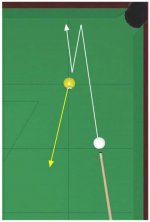Yes, in fact it does - that's what follow is. Overspin means it "peels out" on the cloth like a tire peeling out on pavement. When a rolling CB hits an OB full its forward momentum is stopped (transferred to the OB) and the only thing that then carries it forward is its overspin.Sorry to disagree, but a rolling ball does not 'convert' to Engish over spin after a collision.
Yes, in fact it is (without hitting something like an OB or rail to kill the CB's forward momentum). It's physically difficult for anybody because the upper miscue limit on the CB is a very small distance above the "natural roll" contact point, and any small amount of overspin is quickly worn off by friction with the cloth.It is not difficult 'for me' to put overspin english on a cue ball.
Here's one of Mike Page's excellent videos that explains in more detail:
"Is maximum topspin overspin?"
pj
chgo
